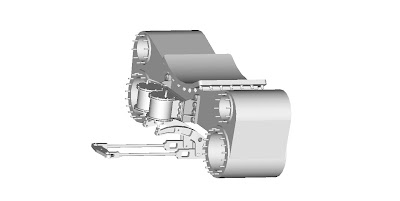THE NAMED STREAMLINERS
just a few of many:
CHICAGO AND NORTHWESTERN'S "400"

It's main claim to fame was that it sported a new type of shock absorber that provided a smoother and quieter ride. Seems to me that it would be the rail that did that.
THE CHESAPEAKE AND OHIO'S "500"

This was the world's first coal-burning steam turbine-electric locomotive . It was 154 feet, 9 3/4 inches long, including it's water tender, and had a top speed of 100mph. The engine alone weighed 411 1/2 tons.
Why was it named the "500"? Well... that was 20% better than calling it the "400", shown above.
THE ILLINOIS CENTRAL'S "GREEN DIAMOND"

Adjustable coach seats - indirect lighting - complete air-conditioning - ash trays at every seat - radio in every car - stewardess - registered nurse - beautifully appointed lounge car - delicious inexpensive meals - tickets at ordinary fares.
That's what it says on the back of this card.
NO, the headlight was not referred to as the "Green Lantern".
THE CHICAGO MILWAUKEE ST.PAUL AND PACIFIC'S "HIAWATHAS"

"Haiwathas"? Yes, there was more than one. At the time, they were considered as the most popular trains in the world.
ZEPHYRS
For a long time, I thought that there was only one "ZEPHYR" and that it went between Denver and somewhere else, that it was the only ever train made of stainless steel, and that it was the only one with that unique front end. Silly me. The railroads, like any other company, were quick to jump on a popular concept and ride it into the ground.
A few of the many ZEPHYRS below:

Yes, it's the "Denver and somewhere" ZEPHYR of my childhood days.
Then there's the below ZEPHYR that did not even get near Denver: The Chicago, Omaha and Lincoln unit.

But it looked like what a true ZEPHYR should look like.
Then came along the Texas ZEPHYR:

Definitely not a true streamlined stainless steel ZEPHYR, it was an attempt to cash in on the magic and allure of the ZEPHYR legend. Perhaps those cars were stainless steel, but I'll bet some very serious money(up to a maximum of one federal reserve dollar) that those very ordinary A and B unit diesels were most likely just painted silver.
And then there's those strange people back on the East coast that wanted their very own ZEPHYR, but just couldn't abide calling it what everybody else did, so they named their ZEPHYR the "FLYING YANKEE". Heh... Maybe they were secretly wishing for more airplanes.

This ZEPHYR was owned and operated by the Boston & Maine RR.
I suppose I should be a bit more diplomatic when bringing up Texans and Yankees - since my wife was born and raised in Boston - and we both live in Texas now.
As usual, you can left click to enlarge all the photos.

















































